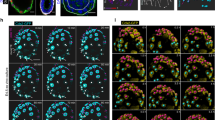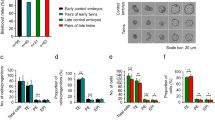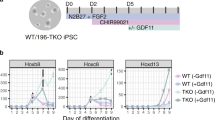Abstract
IN the development of the three-dimensional vertebrate body plan, the left–right axis is linked to the dorsoventral and anterioposterior axes1,2. In humans, altered left–right development results in severe cardiovascular and visceral abnormalities in individuals and in conjoined twins3,4. Although zygotically tran-scribed genes that are asymmetrically expressed have been identified5–8, the mechanism by which left–right asymmetries are established during embryogenesis is unknown9. Here we show that the Xenopus maternal gene Vg1, a member of the TGF-β family of cell-signalling molecules which are implicated in dorsoanterior development10, initiates left–right axis forma-tion. Altered expression of Vg1 on the right side of 16-cell embryos or disruption of endogenous Vg1 signalling on the left side randomizes cardiac and visceral left-right orientation and alters expression of Xnr-1, a nodal-related molecular marker for left–right development8. Furthermore, the orientation of the left–right axis in conjoined twins is dependent upon which cell-signalling molecule initiated twin formation and on whether the secondary axis is on the left or right side of the primary embryonic axis, implicating a molecular pathway leading to the formation of conjoined twins.
This is a preview of subscription content, access via your institution
Access options
Subscribe to this journal
Receive 51 print issues and online access
$199.00 per year
only $3.90 per issue
Buy this article
- Purchase on Springer Link
- Instant access to full article PDF
Prices may be subject to local taxes which are calculated during checkout
Similar content being viewed by others
References
Danos, M. C. & Yost, H. J. Development 121, 1467–1474 (1995).
Danos, M. C. & Yost, H. J. Dev. Biol. 177, 96–103 (1996).
Burn, J. in Ciba Foundation Symposium 282–296 (Wiley, New York, 1991).
Bowers, P. N., Brueckner, M. & Yost, H. J. Prog. Pediat. Cardiol. 6, 53–62 (1996).
Levin, M., Johnson, R. L., Stern, C. D., Kuehn, M. & Tabin, C. Cell 82, 803–814 (1995).
Meno, C. et al. Nature 381, 151–155 (1996).
Collignon, J., Barlet, I. & Robertson, E. J. Nature 381, 155–158 (1996).
Lowe, L. A. et al. Nature 381, 158–161 (1996).
Yost, H. J. Cell 82, 689–692 (1995).
Thomsen, G. H. & Melton, D. A. Cell 74, 433–441 (1993).
Gerhart, J. et al. Development 107, 37–51 (1989).
Lemaire, P., Garrett, N. & Gurdon, J. B. Cell 81, 85–94 (1995).
Boterenbrood, E. C. & Nieuwkoop, P. D. Wilhelm Roux Arch. Dev. Biol. 173, 319–332 (1973).
Rebagliati, M. R., Weeks, D. L., Harvey, R. P. & Melton, D. A. Cell 42, 769–777 (1985).
Dale, L., Matthews, G. & Colman, A. EMBO J. 12, 4471–4480 (1993).
Dohrmann, C. E., Kessler, D. S. & Melton, D. A. Dev. Biol. 175, 108–117 (1996).
Yost, H. J. Nature 357, 158–161 (1992).
Kessler, D. S. & Melton, D. A. Development 121, 2155–2164 (1995).
Hemmati-Brivanlou, A. & Thomsen, G. H. Dev. Genet. 17, 78–89 (1995).
Henry, G. L., Brivanlou, I. H., Kessler, D. S., Hemmatibrivanlou, A. & Melton, D. A. Development 122, 1007–1015 (1996).
Spemann, H. & Falkenberg, H. Arch. Entwicklungsmech. Organismem 45, 371–422 (1919).
Tannahill, D. & Melton, D. A. Development 106, 775–785 (1989).
Dale, L., Matthews, G., Tabe, L. & Colman, A. EMBO J. 8, 1057–1065 (1989).
Ang, S. L. & Rossant, J. Cell 78, 561–574 (1994).
Yisraeli, J. K. & Melton, D. A. Meth. Enzymol. 180, 42–50 (1989).
Jones, C. M., Kuehn, M. R., Hogan, B., Smith, J. C. & Wright, C. V. E. Development 121, 3651–3662 (1995).
Harland, R. M. Meth. Cell Biol. 36, 685–695 (1991).
Smith, W. C. & Harland, R. M. Cell 67, 753–765 (1991).
Author information
Authors and Affiliations
Rights and permissions
About this article
Cite this article
Hyatt, B., Lohr, J. & Yost, H. Initiation of vertebrate left–right axis formation by maternal Vg1. Nature 384, 62–65 (1996). https://doi.org/10.1038/384062a0
Received:
Accepted:
Issue Date:
DOI: https://doi.org/10.1038/384062a0
This article is cited by
-
Maternal control of visceral asymmetry evolution in Astyanax cavefish
Scientific Reports (2021)
-
Phylogenetic evidence for independent origins of GDF1 and GDF3 genes in anurans and mammals
Scientific Reports (2018)
-
Single blastomere expression profiling of Xenopus laevis embryos of 8 to 32-cells reveals developmental asymmetry
Scientific Reports (2013)
-
Cephalothoracopagus, janiceps, disymmetros, monoomphalian conjoined twins undiagnosed until early second trimester
Archives of Gynecology and Obstetrics (2011)
-
Analysis of the asymmetrically expressed Ablim1 locus reveals existence of a lateral plate Nodal-independent left sided signal and an early, left-right independent role for nodal flow
BMC Developmental Biology (2010)
Comments
By submitting a comment you agree to abide by our Terms and Community Guidelines. If you find something abusive or that does not comply with our terms or guidelines please flag it as inappropriate.



